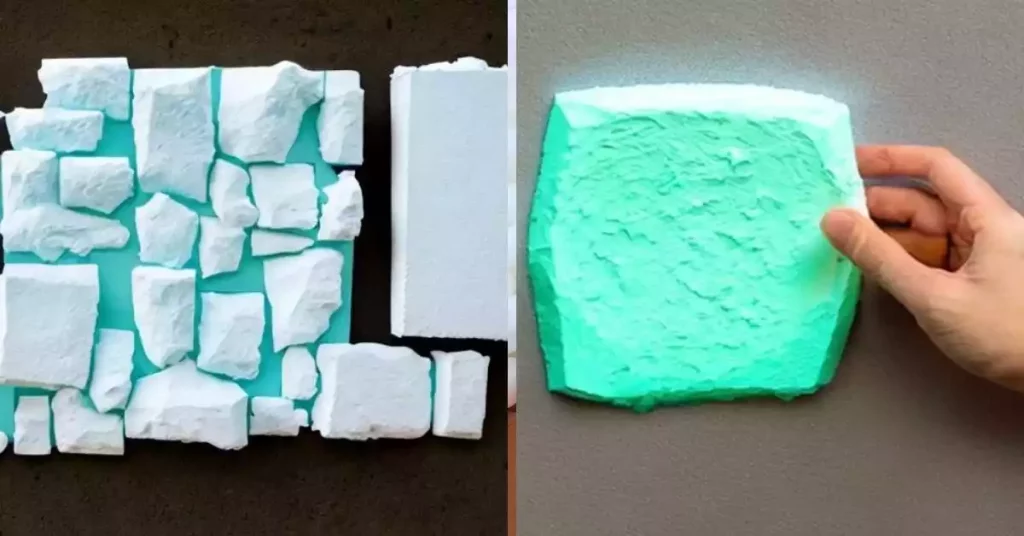Have you ever heard of adding Styrofoam to paint? It’s becoming a popular trend among do-it-yourselfers.
Painting Styrofoam is a great way to enhance its appearance and add an extra touch of creativity to any project.
In this article, I’ll explore why putting styrofoam in the paint can be beneficial and look at some tips for applying it correctly and safely.
Table of Contents
What Is Styrofoam?
Styrofoam is also known as extruded polystyrene (XPS), which is made from styrene material. In order to make Styrofoam, a polymerization is followed.
At first, manufacturers purify the styrene material and transform it into polystyrene. Then, they include a hydrofluorocarbon agent in their making process.
Next, both materials will be extruded from each other and let form a foam board under heavy pressure.
We use Styrofoam for various purposes, such as insulating coolers, cold storage, surfboards, food service, food packaging, different packaging material, etc.
Why Paint on Styrofoam: The Perfect Choice for Arts and Crafts
Paintings on styrofoam can be enjoyed in a number of ways. Some artists use the material to create beautiful artwork, while others use it as a medium for creative writing and artwork.
Putting Styrofoam in paint is a technique used in art and craft projects to create textured or 3D effects. The process involves dipping small pieces of Styrofoam into paint and then applying them to a surface, either individually or in clusters.
In general, there are three types of painting you can do on styrofoam: mural painting, landscape painting, and figure painting.

1. Mural Painting
This type of painting is often done on large walls or ceilings and involves using large pieces of styrofoam to create a mural-like image. The most common mural paint colors are white, black, green, blue, and yellow.
2. Landscape Painting
Landscapes can be created using a variety of materials, including styrofoam, fiberglass filament (or other plastic), and acrylic paint. According to some Artists’ Associations, landscape painters often use bright colors and light textures to produce stunning results.
3. Figure Painting
Figure paintings involve portraying human figures or animals using small pieces of styrofoam. These paintings often have simple designs that require minimal attention to detail.
9 Main Benefits: Why Put Styrofoam in Paint
There are many benefits to putting styrofoam in paint, including being able to maintain your paint job longer and reducing the amount of waste created by painting. I will discuss the eight main benefits of using Styrofoam in paint:
1. Simple and Easy
One of the great things about putting Styrofoam in paint is that it’s a simple and straightforward process. All you need is some Styrofoam, paint, and a few tools.
First, prepare the foam by cutting it into the desired shapes and sizes. Next, dip the foam pieces into the paint, making sure to cover all surfaces. Allow the paint to dry completely, and then you’re ready to apply the foam to your project.
2. Aesthetics
Styrofoam can be painted to match a specific color scheme or design, making it versatile for various projects, such as creating decorative objects, sculptures, or props.
3. Protection
Painting Styrofoam can help protect it from dust, moisture, and other elements that can cause damage over time.
4. Creativity
Painting Styrofoam can also be a fun and creative outlet for artists and hobbyists.
5. Textured surfaces
Using different sizes and shapes of foam makes it possible to create a range of textures, from rough and bumpy to smooth and even.
6. Adding color
The foam can be painted in different colors to create a colorful and eye-catching texture.
7. Decorative elements
The foam can be cut into shapes and painted to create decorative elements, such as flowers, leaves, or other patterns.

Overall, putting Styrofoam in paint is a versatile technique that can add texture, color, and dimension to various art and craft projects.
8. Budget-friendly
Another advantage of putting Styrofoam in paint is that it’s cost-effective. Styrofoam is an inexpensive material, and the paint used in this technique can be purchased in small quantities, making it a budget-friendly option for everyone.
9. Can be Molded and Shaped
The Styrofoam can be molded and shaped to fit the desired effect, making it a versatile material to work with. Whether you want to create a raised design, a 3D effect, or a more intricate pattern, putting Styrofoam in the paint can help you achieve that.
FAQ’s
What Surfaces Can I Use This Painted Styrofoam?
It is suitable for use on most surfaces, including wood, brick, plastic, and concrete.
Is There Any Special Care I Need to Take When Using Styrofoam in Paint?
Make sure that the Styrofoam is completely dry before adding it to the paint, as adding wet Styrofoam could cause the paint to bubble and crack. Additionally, it is important to ensure that the Styrofoam is completely covered by the paint to prevent any pieces from flaking off.
Are There Any Risks Associated with Using Styrofoam in Paint?
Using Styrofoam in paint is generally safe for most applications. But if you don’t use the right paint or don’t prepare the Styrofoam properly before putting it in paint, it can break down over time, making your paint crumble and flake.
Conclusion
No matter the reason, painting Styrofoam can transform it into a more attractive, eye-catching, and durable material for many projects. Whether you’re an artist, hobbyist, or just looking to add something to your next project, this technique is worth exploring. Just make sure to choose the right paint (not melting styrofoam) and follow the proper steps to get the best results.

Even though I have 10+ years of experience in the painting business, I am always trying to learn the latest coloring methods. I have been into colors since my teenage days. I spent a lot of time experimenting with new painting methods on multiple surfaces. Now, I want to spread my knowledge through my blogs and articles.








